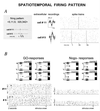Spatiotemporal activity patterns of rat cortical neurons predict responses in a conditioned task
- PMID: 9927701
- PMCID: PMC15358
- DOI: 10.1073/pnas.96.3.1106
Spatiotemporal activity patterns of rat cortical neurons predict responses in a conditioned task
Abstract
Precise and repeated spike-train timings within and across neurons define spatiotemporal patterns of activity. Although the existence of these patterns in the brain is well established in several species, there has been no direct evidence of their influence on behavioral output. To address this question, up to 15 neurons were recorded simultaneously in the auditory cortex of freely moving rats while animals waited for acoustic cues in a Go/NoGo task. A total of 235 significant patterns were detected during this interval from an analysis of 13 hr of recording involving over 1 million spikes. Of particular interest were 129 (55%) patterns that were significantly associated with the type of response the animal made later, independent of whether the response was that prompted by the cue because the response occurred later and the cue was chosen randomly. Of these behavior-predicting patterns, half (59/129) were associated with an enhanced tendency to go in response to the stimulus, and for 11 patterns of this subset, trials including the pattern were followed by significantly faster reaction time than those lacking the pattern. The remaining behavior-predicting patterns were associated with an enhanced NoGo tendency. Overall mean discharge rates did not vary across trials. Hence, these data demonstrate that particular spatiotemporal patterns predict future behavioral responses. Such presignal activity could form templates for extracting specific sensory information, motor programs prespecifying preference for a particular act, and/or some intermediate, associative brain process.
Figures


References
-
- Edelman G M, Mountcastle V B. The Mindful Brain: Cortical Organization and the Group-Selective Theory of Higher Brain Function. Cambridge, MA: MIT Press; 1978.
-
- Segundo J P, Stiber M, Vibert J-F. In: The Handbook of Brain Theory and Neural Networks. Arbib M A, editor. Cambridge, MA: MIT Press; 1995. pp. 953–956.
-
- Vaadia E, Bergman H, Abeles M. IEEE Trans Biomed Eng. 1989;36:25–35. - PubMed
-
- Abeles M. Local Cortical Circuits: An Electrophysiological Study. Berlin: Springer; 1982.
-
- Amit D J. Trends Neurosci. 1998;21:231–237. - PubMed
Publication types
MeSH terms
LinkOut - more resources
Full Text Sources

